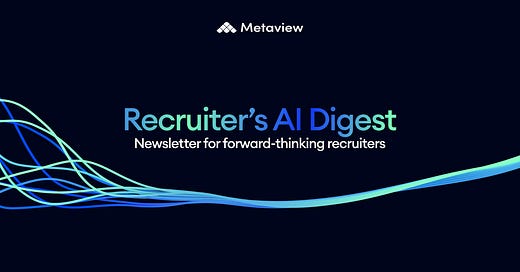Recruiter's AI Digest #71
Resources and perspectives to keep you ahead of the curve as AI deepens its impact in Recruiting. 🤖
Welcome to the community of 3,600 forward-thinking recruiting leaders. 🎉 We stay on the pulse of AI and its impact on recruiting, so you don’t have to!
If you haven’t already, don’t forget to subscribe to this newsletter.
This week’s digest
Recruiting jobs at companies that give their recruiters superpowers https://www.metaview.ai/customers/open-roles
Check out the awesome material this week 📖 :
Hiring.studio (Interview Question Generator)
(Metaview)The Future of Recruiters: AI-Powered Evolution from Talent Scouts to Strategic Leaders
(Kevin Wheeler)AI for work usage
(Ross Dawson)The Rapid Adoption of Generative AI
(Glen Cathey)Big Techs AI Brain Drain Slowing
(Jason Saltzman)
Are there people you know struggling to digest all the AI news? Share this newsletter with them. 🙏
Hiring.studio (Interview Question Generator)
(Metaview)
With Hiring Studio, Metaview has fine-tuned an LLM to:
Collaborate with AI to design interview questions tailored to your recruiting
Automatically create rubrics for what to look for in candidate answers
Listen to sample candidate responses in formats like STAR
Export or share the questions with the rest of your team
The Future of Recruiters: AI-Powered Evolution from Talent Scouts to Strategic Leaders
(Kevin Wheeler)
In his latest piece, Kevin Wheeler explores the progression of recruiters' roles, emphasizing how AI will transition them from tactical recruiters to strategic advisors. This shift will demand new skills, from talent scouting in uncharted networks to aligning hiring with business strategy. Wheeler suggests that as AI takes over routine tasks, recruiters will focus on more impactful, high-level work—provided they're willing to evolve. Adaptation and continuous learning aren’t optional for recruiters aiming to stay relevant.
Key Takeaways:
Talent Scouts (Stage 6)
Role: Identify hidden talent and bridge gaps where AI falls short.
Skills: Relationship-building, digital marketing, and market intelligence.
Activities: Multi-channel engagement, employer branding, competitive analysis.
Strategists (Stage 7)
Role: Align hiring practices with organizational goals.
Skills: Business strategy, advanced data analysis, and change management.
Activities: Develop talent programs, enhance employer branding, use AI for talent intelligence.
Advisors (Stage 8)
Role: Oversee an AI and candidate-driven recruitment process.
Focus: Candidates and hiring managers empowered with AI tools, recruiters offering guidance.
Skills Needed: Mediation, system optimization, bias monitoring.
AI for work usage
(Ross Dawson)
AI tools for work continue to gain traction, with overall usage up by 15% last month. Notably, image generation is still the most widely used category, reflecting its strong demand in the workplace. However, presentation tools showed the most rapid growth, up by 28%, driven by apps like Gamma and Beautiful.ai. Programming and research tools also saw significant gains, both increasing by 23%.
Key Takeaways:
Growth Across Categories: AI usage is expanding in various areas beyond language models (LLMs), indicating broad adoption.
Rising Stars: Presentation tools are gaining popularity as software quality improves, encouraging uptake.
Still Early Days: The AI workspace is evolving, with room for growth as new applications emerge.
See full post here.
The Rapid Adoption of Generative AI
(Glen Cathey)
Generative AI is quickly making its mark, with nearly 40% of working adults already using it. Adoption is higher for personal use (32.7%) compared to workplace use (28%), similar to the early days of the PC revolution.
Key Insights:
Gender Gap in Usage: Men are using AI at work significantly more than women (32.2% vs. 23.3%). This reverses the trend from 1984, when more women adopted computers. This gap suggests issues around access, training, and workplace culture that need attention.
Top Workplace Applications:
Writing communications (38.4%)
Administrative tasks (26.8%)
Translation/summarization (23%)
Adoption Leaders:
STEM professionals and managers show high adoption rates (45.9% and 49%, respectively).
AI use is highest among those with graduate degrees (40.9%).
The Finance, Information, and Real Estate sectors lead in weekly AI use (51.2%).
Fast Adoption Rate: AI adoption is outpacing both the early PC (1984) and internet (1995) adoption curves, with about 40% of adults now using AI.
See LinkedIn post here.
Big Techs AI Brain Drain Slowing
(Jason Saltzman)
From 2021 to mid-2024, Big Tech faced a major challenge in retaining AI/ML talent, with over 11,200 professionals leaving—many to join or launch AI startups. However, things are looking up: AI/ML departures dropped by 54% in Q3 2024 compared to the previous three-year average.
What’s driving the shift? Speculation suggests improved compensation and benefits are playing a role, potentially reversing the talent drain. With more professionals staying put, Big Tech may see a surge in innovation as employees can focus on projects long-term. This could position Big Tech as leaders in the AI space, potentially outpacing many startups.
See the post here.
From the sponsor
Metaview: The world’s #1 AI scribe for recruiting
Metaview uses AI to automatically write your interview, debrief and intake notes for you.
Our summaries are purpose-built for recruiting, so they’re 10x more accurate and relevant than generic transcription tools. And, they work seamlessly with your existing recruiting stack, video conferencing tools, and even mobile calls, so there’s no need to change your existing workflows.









